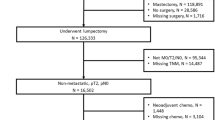Abstract
Introduction
Many eligible women with invasive breast cancer do not receive recommended adjuvant radiation (RT), despite its role in local control and overall survival. We examined trends in RT use over 10 years, and the impact of sociodemographic factors on the receipt of standard-of-care RT, using the National Cancer Database (NCDB).
Materials/methods
Women under age 70 with invasive breast cancer who underwent BCS from 2004 to 2014 were analyzed. Receipt of RT was evaluated in the whole cohort and by time period to identify temporal trends. Multiple logistic regression models were used to assess associations between factors such as race, insurance status, ethnicity, and receipt of RT.
Results
A total of 501,733 patients met eligibility criteria. The percentage of patients undergoing adjuvant RT increased from 86.7% in 2004 to 92.4% in 2012, and then decreased in 2013 and 2014 to 88.9%. On univariate analysis, patients of white race were significantly more likely to receive RT compared with patients of black race (90.4% vs 86.9%, p < 0.0001), as were non-Hispanic women compared to Hispanic patients (90.2% vs. 85.3%, p < 0.0001). On multivariate analysis, race, ethnicity, insurance status, education level, and age remained significantly associated with receipt of RT. On temporal analysis, gaps remained stable, with no significant improvements over time.
Conclusions
This analysis suggests a recent decline in guideline-concordant receipt of RT in women under 70, and persistent disparities in the use of RT after BCS by race, ethnicity, and socioeconomic factors. These findings raise concern for a recent detrimental change in patterns of care delivery.

Similar content being viewed by others
References
Early Breast Cancer Trialists’ Collaborative Group (EBCTCG), Darby S, McGale P et al (2011) Effect of radiotherapy after breast-conserving surgery on 10-year recurrence and 15-year breast cancer death: meta-analysis of individual patient data for 10,801 women in 17 randomised trials. Lancet 378(9804):1707–1716
Clarke M, Collins R, Darby S et al (2005) Effects of radiotherapy and of differences in the extent of surgery for early breast cancer on local recurrence and 15-year survival: an overview of the randomised trials. Lancet 366(9503):2087–2106
Fisher B, Anderson S, Bryant J et al (2002) Twenty-year follow-up of a randomized trial comparing total mastectomy, lumpectomy, and lumpectomy plus irradiation for the treatment of invasive breast cancer. N Engl J Med 347(16):1233–1241
Fyles AW, McCready DR, Manchul LA et al (2004) Tamoxifen with or without breast irradiation in women 50 years of age or older with early breast cancer. N Engl J Med 351(10):963–970
Hughes KS, Schnaper LA, Bellon JR et al (2013) Lumpectomy plus tamoxifen with or without irradiation in women age 70 years or older with early breast cancer: long-term follow-up of CALGB 9343. J Clin Oncol 31(19):2382–2387
Kunkler IH, Williams LJ, Jack WJ, Cameron DA, Dixon JM (2015) PRIME II investigators. Breast-conserving surgery with or without irradiation in women aged 65 years or older with early breast cancer (PRIME II): a randomised controlled trial. Lancet Oncol 16(3):266–273
National comprehensive cancer network breast cancer. https://www.nccn.org/professionals/physician_gls/pdf/breast.pdf
The IDEA Study (Individualized Decisions for Endocrine Therapy Alone) (2015) Retrieved from https://Clinicaltrials.gov/ct2 (identification no. NCT02400190)
The PRECISION Trial (Profiling Early Breast Cancer for Radiotherapy Omission). (2016). A phase II study of breast-conserving surgery without adjuvant radiotherapy for favorable-risk breast cancer. Retrieved from https://Clinicaltrials.gov/ct2 (identification no. NCT02653755)
Du Xianglin L, Gor BJ (2007) Racial disparities and trends in radiation therapy after breast-conserving surgery for early-stage breast cancer in women, 1992 to 2002. Ethn Dis 17(1):122–128
Jagsi R, Abrahamse P, Morrow M et al (2010) Patterns and correlates of adjuvant radiotherapy receipt after lumpectomy and after mastectomy for breast cancer. J Clin Oncol 28(14):2396–2403
Yeboa DN, Xu X, Jones BA, Soulos P, Gross C, Yu JB (2016) Trend in age and racial disparities in the receipt of postlumpectomy radiation therapy for stage I breast cancer: 2004–2009. Am J Clin Oncol 39(6):568–574
Martinez SR, Tseng WH, Shah DR, Canter RJ, Bold RJ (2012) Urban and non-urban disparities in the use of post-mastectomy radiation for breast cancer. Med Oncol 29(3):1523–1528
Parise CA, Bauer KR, Caggiano V (2012) Disparities in receipt of adjuvant radiation therapy after breast-conserving surgery among the cancer-reporting regions of california. Cancer 118(9):2516–2524
Dragun AE, Huang B, Tucker TC, Spanos WJ (2011) Disparities in the application of adjuvant radiotherapy after breast-conserving surgery for early stage breast cancer: impact on overall survival. Cancer 117(12):2590–2598
McClelland S 3rd, Page BR, Jaboin JJ, Chapman CH, Deville C Jr, Thomas CR (2017) Jr. The pervasive crisis of diminishing radiation therapy access for vulnerable populations in the united states, part 1: African-american patients. Adv Radiat Oncol 2(4):523–531
National Comprehensive Cancer Network Breast Cancer (2018) https://www.nccn.org/professionals/physician_gls/pdf/breast.pdf. Accessed 4 Jan 2018.
Darby SC, Ewertz M, Hall P (2013) Ischemic heart disease after breast cancer radiotherapy. N Engl J Med 368(26):2527
Dosch AR, Koru-Sengul T, Miao F, Tannenbaum SL, Byrne MM, Wright JL (2014) Racial and ethnic disparities in the diagnosis of breast cancer: changes in presenting stage in minority populations in florida during 1981–2009. Breast Cancer Res Treat 148(2):379–387
Freedman RA, Virgo KS, He Y et al (2011) The association of race/ethnicity, insurance status, and socioeconomic factors with breast cancer care. Cancer 117(1):180–189
Peipins LA, Graham S, Young R, Lewis B, Flanagan B (2013) Racial disparities in travel time to radiotherapy facilities in the atlanta metropolitan area. Soc Sci Med 89:32–38
Author information
Authors and Affiliations
Corresponding author
Ethics declarations
Conflict of interest
All authors declare that they have no conflict of interest.
Ethical approval
This article does not contain any studies with human participants performed by any of the authors.
Rights and permissions
About this article
Cite this article
Parekh, A., Fu, W., Hu, C. et al. Impact of race, ethnicity, and socioeconomic factors on receipt of radiation after breast conservation surgery: analysis of the national cancer database. Breast Cancer Res Treat 172, 201–208 (2018). https://doi.org/10.1007/s10549-018-4881-0
Received:
Accepted:
Published:
Issue Date:
DOI: https://doi.org/10.1007/s10549-018-4881-0




